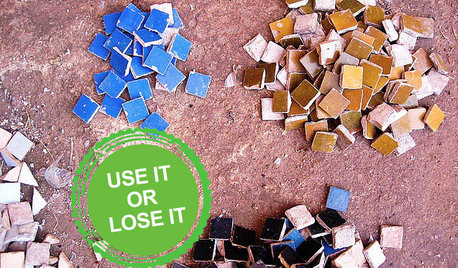How to Properly Dispose of Chlorothalonil?
Ghadames
9 years ago
Related Stories

HOUSEKEEPINGTackle Home Junk With Proper Disposal
No matter how well you scrub, your home will never be spotless until the junk disappears. Here's how to lose it with a clean conscience
Full Story
HOUSEKEEPINGHow to Fix a Stinky Garbage Disposal
No plumber’s fee or even a trip to the hardware store is required with these easy solutions
Full Story
REMODELING GUIDESLose It: What to Do With Leftover Building Materials
See how to properly dispose of your extra brick, wood and paint — or make something cool with it instead
Full Story
DECORATING GUIDESBudget Decorating: How to Decorate Smart and Slow
To make the most of your decorating dollar, forgo the disposable stuff, think vintage and free first and give yourself a splurge
Full Story
LIFEDecluttering — How to Get the Help You Need
Don't worry if you can't shed stuff and organize alone; help is at your disposal
Full Story
HEALTHY HOMEGet the Lead Out: Lead Safety at Home
Keep your family safe by properly testing for and dealing with lead in old painted surfaces, water and soil
Full Story
GARDENING GUIDESHerb Garden Essentials: Grow Your Own Delicious Mint
Pull out a pot for this one. Mint's spreading habit and hard-to-kill nature can be a blessing — if you're properly prepared
Full Story
ORGANIZINGAvoid the Great Paper Pileup
Don't let unavoidable scraps cause a jam in your paperless system. These easy tips will keep your home office lanes clear
Full Story
BATHROOM DESIGNOut With the Old Tile: 8 Steps to Prep for Demolition
This isn't a light DIY project: You'll need heavy-duty tools and plenty of protection for your home and yourself
Full Story
GREEN BUILDINGOff the Grid: Ready to Pull the Plug on City Power?
What to consider if you want to stop relying on public utilities — or just have a more energy-efficient home
Full StoryMore Discussions








franktank232
jean001a
Related Professionals
Prairie Ridge Landscape Architects & Landscape Designers · Middletown Landscape Contractors · Stoughton Landscape Contractors · Brookside Landscape Contractors · Azalea Park Landscape Contractors · Belvedere Park Landscape Contractors · Biloxi Landscape Contractors · Emmaus Landscape Contractors · Fort Worth Landscape Contractors · Natick Landscape Contractors · Ramsey Landscape Contractors · Royal Oak Landscape Contractors · Selden Landscape Contractors · Wilsonville Landscape Contractors · Shafter Landscape Contractorsalan haigh
PupillaCharites
GhadamesOriginal Author
ltilton
ken_adrian Adrian MI cold Z5
ken_adrian Adrian MI cold Z5
GhadamesOriginal Author
ltilton
mes111
ferroplasm Zone 7b
GhadamesOriginal Author
alan haigh
mes111